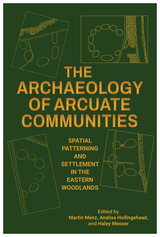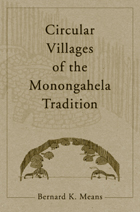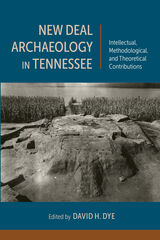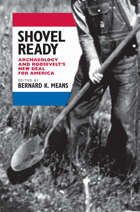4 books about Means, Bernard K.

The Archaeology of Arcuate Communities
Spatial Patterning and Settlement in the Eastern Woodlands
Edited by Martin Menz, Analise Hollingshead, and Haley Messer
University of Alabama Press, 2024
The Archaeology of Arcuate Communities is an edited collection of ten essays that illuminate how Indigenous communities of the Eastern Woodlands, from 10,000 BC to the 1550s, are analyzed and interpreted by archaeologists today. Volume editors Martin Menz, Analise Hollingshead, and Haley Messer define the persistent circular or “arcuate” pattern of Native settlements in this region as a spatial manifestation of community activities that reinforced group identity alongside plazas, mounds, and other architectural features.
The varied case studies in this volume focus on specific communities, how they evolved, and the types of archaeological data that have been used to assess them. Part I, “Defining the Domestic Unit in Arcuate Communities,” reveals social distinctions between households and household clusters in arcuate communities, how they differ in terms of stylistic patterns and exchange, and how they combined to form distinct social groups at different scales within a broader community. Part II, “Organizing Principles of Arcuate Communities,” broadens the scope to identify the organizing principles of entire arcuate communities, such as the central role of plazas in structuring their development, how the distribution of households and central features within communities was contested and reorganized, and the importance of mounds in both delineating arcuate communities and marking their position on the landscape. Part III, “Comparison and Change in Arcuate Communities,” comprises case studies that examine changes in the organization of arcuate communities over time. Rounding out the volume is a concluding chapter that assesses how and why communities around the world formed in circular patterns.
A valuable resource for archaeologists, this collection will also be of interest to those seeking to learn about Native North American settlement, ceremony, and community organization.
The varied case studies in this volume focus on specific communities, how they evolved, and the types of archaeological data that have been used to assess them. Part I, “Defining the Domestic Unit in Arcuate Communities,” reveals social distinctions between households and household clusters in arcuate communities, how they differ in terms of stylistic patterns and exchange, and how they combined to form distinct social groups at different scales within a broader community. Part II, “Organizing Principles of Arcuate Communities,” broadens the scope to identify the organizing principles of entire arcuate communities, such as the central role of plazas in structuring their development, how the distribution of households and central features within communities was contested and reorganized, and the importance of mounds in both delineating arcuate communities and marking their position on the landscape. Part III, “Comparison and Change in Arcuate Communities,” comprises case studies that examine changes in the organization of arcuate communities over time. Rounding out the volume is a concluding chapter that assesses how and why communities around the world formed in circular patterns.
A valuable resource for archaeologists, this collection will also be of interest to those seeking to learn about Native North American settlement, ceremony, and community organization.
[more]

Circular Villages of the Monongahela Tradition
Bernard K. Means
University of Alabama Press, 2007
Between A.D. 1000 and 1635, the inhabitants of southwestern Pennsylvania and portions of adjacent states—known to archaeologists as the Monongahela Culture or Tradition—began to reside regularly in ring-shaped village settlements. These circular settlements consisted of dwellings around a central plaza. A cross-cultural and cross-temporal review of archaeological, ethnohistorical, and ethnographic cases demonstrates that this settlement form appeared repeatedly and independently worldwide, including throughout portions of the Eastern Woodlands, among the Plains Indians, and in Central and South America.
Specific archaeological cases are drawn from Somerset County, Pennsylvania, that has the largest number of completely excavated Monongahela villages. Most of these villages, excavated in the 1930s as federal relief projects, were recently dated. Full analysis of the extensive excavations reveals not only the geometric architectural patterning of the villages, but enables an analysis of the social groupings, population estimates, and economic status of residents who inhabited the circular villages. Circular patterning can be revealed at less fully excavated archaeological sites. Focused test excavations can help confirm circular village plans without extensive and destructive excavations.
[more]

New Deal Archaeology in Tennessee
Intellectual, Methodological, and Theoretical Contributions
Edited by David H. Dye
University of Alabama Press, 2016
New Deal Archaeology in Tennessee is a collection of essays that explore how contemporary archaeology was catalyzed and shaped by the archaeological revolution during the New Deal era.
New Deal Archaeology in Tennessee tells the engrossing story of Southeastern archaeology in the 1930s. The Tennessee Valley Authority Act of May 1933 initiated an ambitious program of flood control and power generation by way of a chain of hydroelectric dams on the Tennessee River. The construction of these dams flooded hundreds of thousands of square miles of river bottoms, campsites, villages, and towns that had been homes to Native Americans for centuries. This triggered an urgent need to undertake extensive archaeological fieldwork throughout the region. Those studies continue to influence contemporary archaeology.
The state of Tennessee and the Tennessee Valley were especially well suited research targets thanks to their mild climate and long field seasons. A third benefit in the 1930s was the abundance of labor supplied by Tennesseans unemployed during the Great Depression. Within months of the passage of the Tennessee Valley Authority Act, teams of archaeologists fanned out across the state and region under the farsighted direction of Smithsonian Institution curators Neil M. Judd, Frank H. H. Roberts, and Frank M. Setzler. The early months of 1934 would become the busiest period of archaeological fieldwork in US history.
The twelve insightful essays in New Deal Archaeology in Tennessee document and explore this unique peak in archaeological study. Chapters highlight then-new techniques such as mound “peeling” and stratigraphic excavation adapted from the University of Chicago; the four specific New Deal sites of Watts Bar Reservoir, Mound Bottom, Pack, and Chickamauga Basin; bioarchaeology in the New Deal; and the enduring impact of the New Deal on contemporary fieldwork.
The challenges of the 1930s in recruiting skilled labor, training unskilled ancillary labor, developing and improvising new field methods, and many aspects of archaeological policies, procedures, and best-practices laid much of the foundation of contemporary archaeological practice. New Deal Archaeology in Tennessee offers an invaluable record of that pivotal time for professional, student, and amateur archaeologists.
New Deal Archaeology in Tennessee tells the engrossing story of Southeastern archaeology in the 1930s. The Tennessee Valley Authority Act of May 1933 initiated an ambitious program of flood control and power generation by way of a chain of hydroelectric dams on the Tennessee River. The construction of these dams flooded hundreds of thousands of square miles of river bottoms, campsites, villages, and towns that had been homes to Native Americans for centuries. This triggered an urgent need to undertake extensive archaeological fieldwork throughout the region. Those studies continue to influence contemporary archaeology.
The state of Tennessee and the Tennessee Valley were especially well suited research targets thanks to their mild climate and long field seasons. A third benefit in the 1930s was the abundance of labor supplied by Tennesseans unemployed during the Great Depression. Within months of the passage of the Tennessee Valley Authority Act, teams of archaeologists fanned out across the state and region under the farsighted direction of Smithsonian Institution curators Neil M. Judd, Frank H. H. Roberts, and Frank M. Setzler. The early months of 1934 would become the busiest period of archaeological fieldwork in US history.
The twelve insightful essays in New Deal Archaeology in Tennessee document and explore this unique peak in archaeological study. Chapters highlight then-new techniques such as mound “peeling” and stratigraphic excavation adapted from the University of Chicago; the four specific New Deal sites of Watts Bar Reservoir, Mound Bottom, Pack, and Chickamauga Basin; bioarchaeology in the New Deal; and the enduring impact of the New Deal on contemporary fieldwork.
The challenges of the 1930s in recruiting skilled labor, training unskilled ancillary labor, developing and improvising new field methods, and many aspects of archaeological policies, procedures, and best-practices laid much of the foundation of contemporary archaeological practice. New Deal Archaeology in Tennessee offers an invaluable record of that pivotal time for professional, student, and amateur archaeologists.
[more]

Shovel Ready
Archaeology and Roosevelt's New Deal for America
Bernard K. Means
University of Alabama Press, 2013
Shovel Ready provides a comprehensive lens through which to view the New Deal period, a fascinating and prolific time in American archaeology.
In this collection of diverse essays united by a common theme, Bernard K. Means and his contributors deliver a valuable research tool for practicing archaeologists and historians of archaeology, as well as New Deal scholars in general.
To rescue Americans from economic misery and the depths of despair during the Great Depression, President Franklin Delano Roosevelt created several New Deal jobs programs to put people to work. Men and women labored on a variety of jobs, from building roads to improving zoos. Some ordinary citizens—with no prior experience—were called on to act as archaeologists and excavate sites across the nation, ranging in size from small camps to massive mound complexes, and dating from thousands of years ago to the early Colonial period.
Shovel Ready contains essays on projects ranging across the breadth of the United States, including New Deal investigations in California, Georgia, Illinois, Iowa, Kentucky, New Jersey, Oklahoma, Pennsylvania, Tennessee, and Texas. Some essays engage in historical retrospectives. Others bring the technologies of the twenty-first century, including accelerator mass spectrometry (AMS) dating of curated collections and geophysical surveys at New Deal–excavated sites, to bear on decades-old excavations. The volume closes with an investigation into material remnants of the New Deal itself.
Contributors
John L. Cordell / John F. Doershuk / David H. Dye /Scott W. Hammerstedt / Janet R. Johnson / Kevin Kiernan /Gregory D. Lattanzi /Patrick C. Livingood / Anna R. Lunn / Bernard K. Means / Stephen E. Nash / Amanda L. Regnier / Sissel Schroeder / James R. Wettstaed
John L. Cordell / John F. Doershuk / David H. Dye /Scott W. Hammerstedt / Janet R. Johnson / Kevin Kiernan /Gregory D. Lattanzi /Patrick C. Livingood / Anna R. Lunn / Bernard K. Means / Stephen E. Nash / Amanda L. Regnier / Sissel Schroeder / James R. Wettstaed
[more]
READERS
Browse our collection.
PUBLISHERS
See BiblioVault's publisher services.
STUDENT SERVICES
Files for college accessibility offices.
UChicago Accessibility Resources
home | accessibility | search | about | contact us
BiblioVault ® 2001 - 2024
The University of Chicago Press









